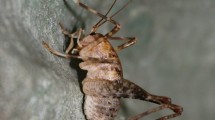Summary
-
1.
The sensory basis of sound and vibration perception has been studied neurophysiologically in the ghost crab Ocypode. Experiments were carried out both on neural responses from the brains of intact animals and on nerve responses recorded from isolated walking legs.
-
2.
Hearing curves for two species of Ocypode from about 800 Hz to 3000 Hz showed maximum sensitivities in the 1–2 kHz band.
-
3.
The substratum vibration sensitivity curve for Ocypode ceratophthalmus extended to 5000 Hz.
-
4.
Synchrony between the response and the stimulus was seen for low frequency vibrations up to 600–800 Hz.
-
5.
Sensitivity to high frequency vibrations and sounds was localized in Barth's myochordotonal organ in the merus of each walking leg.
-
6.
This system could be used for conspecific call detection, and may provide sufficient information to the animals for orientation to acoustically signalling individuals.
Similar content being viewed by others
References
Aurivillius, C. W. S.: Die Beziehungen der Sinnesorgane amphibischer Dekapoden zur Lebensweise und Atmung. Nova Acta Reg. Soc. Sci. Upsaliensis, Ser. 3, 16, 1–48 (1893).
Autrum, H.: Anatomy and physiology of sound receptors in invertebrates. In: Acoustic behaviour of animals (R.-G. Busnel, ed.), p. 412–433. Amsterdam: Elsevier 1963.
Barth, G.: Untersuchungen über Myochordotonalorgane bei dekapoden Crustaceen. Z. wiss. Zool. 145, 576–624 (1934).
Bergeijk, W. A. van: The evolution of vertebrate hearing. In: Contributions to sensory physiology, Bd. 2 (W. D. Neff, ed.), p. 1–9. New York: Academic Press 1967.
Burke, W.: An organ for proprioception and vibration sense in Carcinus maenas. J. exp. Biol. 31, 127–138 (1954).
Clarac, F.: Proprioceptor anatomy of the ischio-meropodite region in legs of the crab Carcinus mediterraneus C. Z. vergl. Physiol. 61, 203–223 (1968a).
—: Proprioception by the ischio-meropodite region in legs of the crab Carcinus mediterraneus C. Z. vergl. Physiol. 61, 224–245 (1968 b).
—, Masson, C.: Anatomie compareé des propriocepteurs de la région basi-ischioméropodite chez certains crustacés décapodes. Z. vergl. Physiol. 65, 242–273 (1969).
Cohen, M. J.: The function of receptors in the statocyst of the lobster Homarus americanus. J. Physiol. (Lond.) 130, 9–34 (1955).
—: The crustacean myochordotonal organ as a proprioceptive system. Comp. Biochem. Physiol. 8, 223–243 (1963).
—: The dual role of sensory systems: detection and setting central excitability. Cold Spr. Harb. Symp. quant. Biol. 30, 587–599 (1965).
—, Dijkgraaf, S.: Mechanoreception. In: Physiology of Crustacea (T. H. Waterman, ed.), p. 65–108. New York: Academic Press 1961.
Cowles, R. P.: Habits, reactions, and associations in Ocypoda arenaria. Papers from the Tortugas Laboratory, Carnegie Insitution, Washington 2, 1–41 (1908).
Dumortier, B.: Morphology of sound emission apparatus in Arthropoda. In: Acoustic behaviour of animals (R.-G. Busnel, ed.), p. 277–345. Amsterdam: Elsevier 1963.
Frings, H.: Problems and prospects in research on marine invertebrate sound production and reception. In: Marine bio-acoustics (W. N. Tavolga, ed.), p. 155–173. New York: Pargamon Press 1964.
George, R. W., Knott, M. E.: The Ocypode ghost crabs of western Australia (Crustacea, Brachyura). J. roy. Soc. W. Australia 48, 15–21 (1965).
Green, J. D.: A simple microelectrode for recording from the central nervous system. Nature (Lond.) 182, 962 (1958).
Guinot-Dumortier, D., Dumortier, B.: La stridulation chez les crabes. Crustaceana 1, 117–155 (1960).
Harris, G. G.: Considerations on the physics of sound production by fishes. In: Marine bio-acoustics (W. N. Tavolga, ed.), p. 233–247. New York: Pergamon Press 1964.
Haskell, P. T.: Insect sounds. Chicago: Quadrangle Books 1961.
Hensen, V.: Studien über das Gehörorgan der Decapoden. Z. wiss. Zool. 13, 319–402 (1863).
Horch, K. W., Salmon, M.: Production, perception and reception of acoustic stimuli by semiterrestrial crabs (Genus Ocypode and Uca, Family Ocypodidae). Forma et Functio 1, 1–25 (1969).
Hwang, J. C. C.: The function of a second sensory cell group in the accessory-flexor proprioceptive system of crab limbs. Amer. Zool. 1, 453 (1961).
Ortmann, A. E.: Die Klassen und Ordnungen der Arthropoden. In: Bronn's Klassen des Thier-Reichs, Bd. 5, Abt. II. Leipzig: Malacostraca. 1901.
Peterson, A. P. G., Gross, E. E., Jr.: Handbook of noise measurement. West Concord, Mass.: General Radio Co. 1967.
Rathbun, M. J.: The grapsoid crabs of America. U. S. nat. Mus. Bull. 97, 1–461 (1918).
Sakai, T.: Crabs of Japan. Tokyo: Sanseido Co. 1935.
Salmon, M., Atsaides, S. P.: Visual and acoustical signalling during courtship byfiddler crabs (Genus Uca). Amer. Zool. 8, 623–639 (1968).
—: Sensitivity to substrate vibration in the fiddler crab, Uca pugilator Bosc. Anim. Behav. 17, 68–76 (1969).
Horch, K.: Acoustical signalling and detection by semiterrestrial crabs in the Family Ocypodidae. In: Recent advances in the behavior of marine animals. (H. E. Winn & B. Olla, eds.). In press.
Schmitt, W. L.: Crustaceans. Ann Arbor: Univ. Michigan Press 1965.
Taylor, R. C.: Water-vibration reception: a neurophysiological study in unrestrained crayfish. Comp. Biochem. Physiol. 27, 795–805 (1968).
Author information
Authors and Affiliations
Additional information
This work was done while the author was supported by a NSF Predoctoral Fellowship. I thank Drs. F. Clarac and M. J. Cohen for their help with aspects of MCO anatomy, and Drs. M. Salmon and T. H. Waterman for their valuable assistance in preparing this paper.
Rights and permissions
About this article
Cite this article
Horch, K. An organ for hearing and vibration sense in the ghost crab Ocypode . Z. Vergl. Physiol. 73, 1–21 (1971). https://doi.org/10.1007/BF00297698
Received:
Issue Date:
DOI: https://doi.org/10.1007/BF00297698




